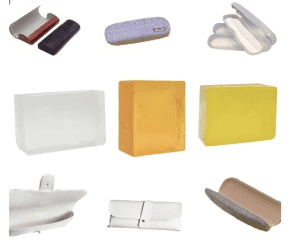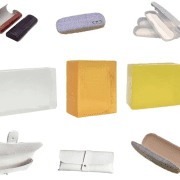Application of Hot Melt Adhesives in Eyeglass Case Manufacturing
Hot melt adhesives have become an essential bonding material in the production of eyeglass cases due to their versatility, durability, and efficiency. These adhesives provide strong adhesion to a wide range of substrates, offer clean and efficient processing, and ensure long-term stability of the finished products. Depending on the type of eyeglass case—metal, plastic, leather, nylon, or wood—hot melt adhesives play a specific role in ensuring both functionality and aesthetics
For metal eyeglass cases, hot melt adhesives are mainly used to bond the inner lining materials, such as fabric or velvet, to the rigid metal shell. This creates a soft protective interior that prevents scratches on lenses while maintaining a firm structure. The quick-setting property of hot melts is particularly advantageous in mass production, where speed and precision are critical.
In plastic cases, hot melt adhesives are applied to secure inner layers, coverings, or decorative films. Plastics often require adhesives that can bond well despite smooth and sometimes low-energy surfaces. Formulated hot melts ensure reliable adhesion, preventing peeling or detachment during use. Additionally, the flexibility of the adhesive allows the case to open and close repeatedly without weakening the bond.
For leather eyeglass cases, hot melt adhesives serve both structural and aesthetic functions. They are used to attach leather or synthetic PU leather coverings to the inner stiffeners, often made of cardboard or plastic. Hot melts create a smooth, wrinkle-free surface while providing the strength needed for everyday handling. Their clean bonding ensures that no residue seeps through the leather surface, which is essential for premium-quality products.
Nylon and EVA-based eyeglass cases, often used for sports and outdoor eyewear, rely on hot melt adhesives for bonding outer nylon fabrics to molded EVA or plastic shells. These adhesives provide durability, flexibility, and resistance to temperature variations, ensuring the case maintains its protective qualities under different environmental conditions. The heat resistance of hot melts also ensures that the adhesive does not degrade during storage or outdoor use.
For wooden eyeglass cases, hot melt adhesives are typically employed to attach lining fabrics and cushioning materials inside the rigid wooden frame. Since wood is porous, hot melts penetrate slightly into the surface, forming a secure and lasting bond. This combination of natural wood aesthetics with reliable adhesive bonding produces cases that are both elegant and durable.
In conclusion, hot melt adhesives are indispensable in modern eyeglass case manufacturing. Their adaptability across different materials—metal, plastic, leather, nylon, and wood—ensures that manufacturers can achieve both structural integrity and visual appeal. By providing strong adhesion, fast processing, and long-term reliability, hot melt adhesives have become a cornerstone of efficient and high-quality eyeglass case production.

